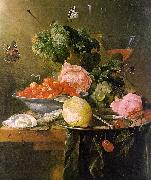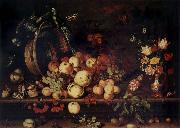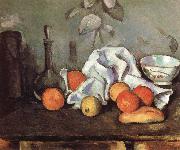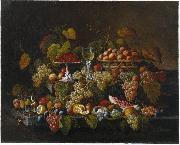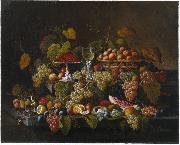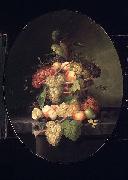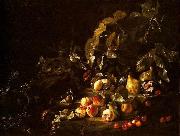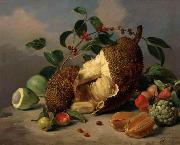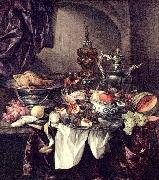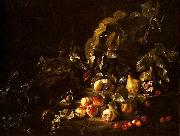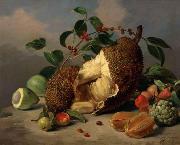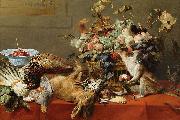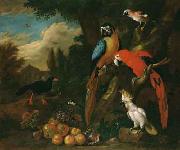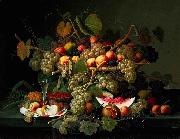Wholesale Oil Painting No Minimum |
|||||||||||
|
|
|||||||||||

|
|||||||||||
|
|
|
||||||||
Jan Dirksz BothDutch 1610-1652 Jan Dirksz Both (between 1610 and 1618, Utrecht - Aug 9 1652, Utrecht), brother of Andries Both, was a Dutch painter. From 1634 to 1637 he was taught by Bloemaert and the painter Gerard van Honthorst before travelling to Rome ca. 1637. There he met the French painter Claude Lorrain, with whom he collaborated on a series of landscape paintings. His landscapes are typically peopled by peasants driving cattle or travellers gazing on Roman ruins in the light of the evening sun The everyday life of the streets of Rome became a favourite theme in his works. On his return to Utrecht after the death of his brother in 1642, he stopped producing genre pieces and focused instead on pictures of Italian landscapes bathed in a warm, golden light. This theme was adopted by several other Dutch painters, the Italianites. |
||||||||
|
|
||||||||
Still Life with Fruit
Still Life with Fruit Painting ID:: 1592 |
1652
Nardoni Galerie, Prague 1652 Nardoni Galerie, Prague |
|||||||
|
|
||||||||
Nicolae GrigorescuRomanian Painter, 1838-1907 From 1848 he trained in Bucharest with various church painters, producing icons and religious mural decorations. These works, which soon attracted attention, were influenced in style by the Viennese classicism widespread in the Romanian principalities in the early 19th century and by the Italian academicism established there after 1850 by Gheorghe Tattarescu. The earliest of his known paintings are in the church of SS Constantin and Elena at Baicoi, where his signature can be seen beside that of Nita Pereescu on the icon of St George (1853). He subsequently painted a series of icons (1854-5) at Caldarusani Monastery. In the later ensembles he was assisted by his older brother Georghe Grigorescu, who participated under his direction in the decoration of churches, such as those of the Zamfira (1856-8) and Agapia (1858-60) monasteries. In Nicolae's paintings at Agapia, classicism in Romanian art reached its highest point. The royal icons are distinguished for the elegance of the figures, both in their attitudes and in their drapery. |
||||||||
|
|
||||||||
|
|
Still Life with Fruit
Still Life with Fruit Painting ID:: 30750 |
nn06
1869
oil on canvas glued on wood
38x71cm
nn06 1869 oil on canvas glued on wood 38x71cm |
||||||
|
|
||||||||
Jean Baptiste OudryFrench Baroque Era Painter, 1686-1755 French painter. He was the principal animal painter and one of the foremost decorative painters during the first half of Louis XVs reign. After initial training as a portrait painter, he concentrated on still-lifes; by the 1720s he had also begun to establish himself as a specialist in hunting scenes, game-pieces and portraits of animals. He ran an active workshop, often keeping his best originals for years and selling copies and (more or less autograph) variants. In the 1730s he was most active as a tapestry designer, making numerous designs for the royal tapestry works of Beauvais and the Gobelins, and he continued to produce his brilliantly painted hunts, still-lifes and studies of animals and birds to the end of his career. |
||||||||
|
|
||||||||
|
|
Still Life with Fruit
Still Life with Fruit Painting ID:: 40536 |
mk156
1721
Oil on canvas
74x92cm
mk156 1721 Oil on canvas 74x92cm |
||||||
|
|
||||||||
AST, Balthasar van derDutch Baroque Era Painter, ca.1593-1656 1657). Dutch painter. He was the brother-in-law of Ambrosius Bosschaert (i), whose household he entered in 1609, after the death of his father. He remained as Bosschaert's pupil, until he was 21. In 1615 van der Ast moved with the Bosschaert family to Bergen-op-Zoom. However, a year later the Bosschaerts were living in Utrecht, but van der Ast is not recorded there until 1619, when he was entered as a master in the Guild of St Luke. He remained in Utrecht until 1632, then lived in Delft, where he enrolled in the painters' guild on 22 June 1632. On 26 February 1633 he married Margrieta Jans van Bueren in Delft, where he spent the rest of his career; the marriage produced two children. |
||||||||
|
|
||||||||
|
|
Still life with Fruit
Still life with Fruit Painting ID:: 41033 |
mk159
1620s
Oil on panel
75x104cm
mk159 1620s Oil on panel 75x104cm |
||||||
|
|
||||||||
Paul CezanneFrench Post-Impressionist Painter, 1839-1906 During the second half of the 19th century French impressionism created a dramatic break with the art of the past. In conception and appearance the style was radically new and, although it initially inspired public ridicule, it soon affected nearly every ambitious artist in western Europe. The new vision emerged during the 1870s, chiefly in the art of Claude Monet, Auguste Renoir, and Camille Pissarro. For each of these artists impressionism was an illusionistic style which differed from the tradition of Renaissance illusionism in its greater emphasis upon vibrant, natural color and on an immediate confrontation with the phenomena of the visible world. As the style developed during the 1880s, however, it increasingly became characterized by paintings which were flat rather than illusionistic. In other words, the impressionists insistence upon a direct application of pigment to canvas resulted in surfaces which declared themselves first of all as surfaces - and, consequently, in paintings which declared themselves first of all as paintings rather than as windows which looked out upon the natural world. The tendency toward flatness persisted into the last years of the 19th century, its pervasiveness giving the impression that illusionistic space - fought for, won, and defended since the very beginning of the Renaissance - had finally been sacrificed by the medium of painting. Paul C??zanne worked within and finally emerged from this trend. As a painter, he matured slowly, his greatest works coming during the last 25 years of his life. During this period he scored a remarkable and heroic achievement: he restored to painting the space and volume that had seemingly been lost to it. But he did it in a totally unprecedented way: not by return to the illusionism of the past but by the creation of a spatial illusionism that did not violate flatness. C??zanne was born on Jan. 19, 1839, in Aix-en-Provence. His father, Philippe Auguste, was the cofounder of a banking firm which prospered throughout the artist life, affording him financial security that was unavailable to most of his contemporaries and eventually resulting in a large inheritance. In 1852 C??zanne entered the Coll??ge Bourbon, where he met and became friends with Émile Zola. This friendship was decisive for both men: with youthful romanticism they envisioned successful careers in the Paris art world, C??zanne as a painter and Zola as a writer. Consequently, C??zanne began to study painting and drawing at the École des Beaux-Arts in Aix in 1856. His father opposed the pursuit of an artistic career, and in 1858 he persuaded C??zanne to enter law school at the University of Aix. Although C??zanne continued his law studies for several years, he was simultaneously enrolled in the School of Design in Aix, where he remained until 1861. In 1861 C??zanne finally convinced his father to allow him to go to Paris. He planned to join Zola there and to enroll in the École des Beaux-Arts. But his application was rejected and, although he had gained inspiration from visits to the Louvre, particularly from the study of Diego Vel??zquez and Caravaggio, C??zanne experienced self-doubt and returned to Aix within the year. He entered his father banking house but continued to study at the School of Design. The remainder of the decade was a period of flux and uncertainty for C??zanne. His attempt to work in his father business was abortive, and he returned to Paris in 1862 and stayed for a year and a half. During this period he met Monet and Pissarro and became acquainted with the revolutionary work of Gustave Courbet and Édouard Manet. C??zanne also admired the fiery romanticism of Eug??ne Delacroix paintings. But he was never entirely comfortable with Parisian life and periodically returned to Aix, where he could work in relative isolation. He retreated there, for instance, during the Franco-Prussian War (1870-1871). |
||||||||
|
|
||||||||
|
|
Still Life with Fruit
Still Life with Fruit Painting ID:: 54041 |
mk235
1879/80
Oil on canvas
45x54cm
mk235 1879/80 Oil on canvas 45x54cm |
||||||
|
|
||||||||
Severin Roesen1848-1871 Severin Roesen (ca. 1815-1872) is a painter known for his abundant fruit and flower still lifes and is today recognized as one of the major American still-life painters of the mid-nineteenth century. Born in Cologne, in Germany, he emigrated to the United States in 1848. While Roesen's paintings reveal a meticulous attention to detail in their precise arrangements and close brushwork, his subject matter, even down to specific motifs, did not change throughout his career. Sometimes he made near copies of paintings, but usually he merely rearranged and reassembled stock elements. Numerous items in Fruit and Wine Glass, for example, also appear in other paintings. The footed desert plate full of strawberries is a common motif. The pilsner glass, sometimes accompanied by an open bottle of champagne, is interchangeable with a wine goblet filled with lemonade used elsewhere. The glass is nearly always placed at the lower left edge of the painting; a halved lemon often appears nearby. Branches full of grapes arranged from lower left to upper right provide the composition with a graceful S-curve and subtly lead the viewer's eye over the entire display. Here the composition is balanced by light and dark grapes at either side and filled in by scattered raspberries, cherries, peaches, apples, pears, and apricots. Many of these compositional elements, if not the items depicted, were derived from seventeenth-century Dutch still life paintings by such artists as Jan van Huysem. |
||||||||
|
|
||||||||
|
|
Still Life with Fruit
Still Life with Fruit Painting ID:: 71321 |
between 1858(1858) and 1862(1862)
Oil on canvas
101.7 x 127.3 cm (40.04 x 50.12 in)
between 1858(1858) and 1862(1862) Oil on canvas 101.7 x 127.3 cm (40.04 x 50.12 in) |
||||||
|
|
||||||||
Severin Roesen1848-1871 Severin Roesen (ca. 1815-1872) is a painter known for his abundant fruit and flower still lifes and is today recognized as one of the major American still-life painters of the mid-nineteenth century. Born in Cologne, in Germany, he emigrated to the United States in 1848. While Roesen's paintings reveal a meticulous attention to detail in their precise arrangements and close brushwork, his subject matter, even down to specific motifs, did not change throughout his career. Sometimes he made near copies of paintings, but usually he merely rearranged and reassembled stock elements. Numerous items in Fruit and Wine Glass, for example, also appear in other paintings. The footed desert plate full of strawberries is a common motif. The pilsner glass, sometimes accompanied by an open bottle of champagne, is interchangeable with a wine goblet filled with lemonade used elsewhere. The glass is nearly always placed at the lower left edge of the painting; a halved lemon often appears nearby. Branches full of grapes arranged from lower left to upper right provide the composition with a graceful S-curve and subtly lead the viewer's eye over the entire display. Here the composition is balanced by light and dark grapes at either side and filled in by scattered raspberries, cherries, peaches, apples, pears, and apricots. Many of these compositional elements, if not the items depicted, were derived from seventeenth-century Dutch still life paintings by such artists as Jan van Huysem. |
||||||||
|
|
||||||||
|
|
Still Life with Fruit
Still Life with Fruit Painting ID:: 72428 |
Date between 1858(1858) and 1862(1862)
Medium Oil on canvas
Dimensions 101.7 X 127.3 cm (40.04 X 50.12 in)
cyf Date between 1858(1858) and 1862(1862) Medium Oil on canvas Dimensions 101.7 X 127.3 cm (40.04 X 50.12 in) cyf |
||||||
|
|
||||||||
|
|
||||||||
|
|
Still Life with Fruit
Still Life with Fruit Painting ID:: 72644 |
Date ca. 1869(1869)
Medium Oil on canvas
Dimensions 86 X 67.8 cm (33.86 X 26.69 in)
cyf Date ca. 1869(1869) Medium Oil on canvas Dimensions 86 X 67.8 cm (33.86 X 26.69 in) cyf |
||||||
|
|
||||||||
Abraham Brueghel(1631-1690) was a Flemish painter from the famous family of artists. He was the son of Jan Brueghel the Younger, the grandson of Jan Brueghel the Elder and the great-grandson of Pieter Brueghel the Elder. |
||||||||
|
|
||||||||
|
|
Still life with fruit
Still life with fruit Painting ID:: 75153 |
from 1675(1675) until 1680(1680)
Oil on canvas
72 X 97 cm (28.35 X 38.19 in)
cjr from 1675(1675) until 1680(1680) Oil on canvas 72 X 97 cm (28.35 X 38.19 in) cjr |
||||||
|
|
||||||||
|
|
||||||||
|
|
Still life with fruit
Still life with fruit Painting ID:: 75174 |
ca. 1873(1873)
Oil on canvas
53.8 X 67 cm (21.18 X 26.38 in)
cjr ca. 1873(1873) Oil on canvas 53.8 X 67 cm (21.18 X 26.38 in) cjr |
||||||
|
|
||||||||
Abraham van Beijeren(ca. 1620 - March 1690) was a Dutch Baroque era painter. He was little regarded in his day but is now considered one of the greatest of still-life painters. Van Beijeren (alternatively spelled "Beyeren") lived in a succession of Dutch towns. Born in The Hague, the artist also lived in Delft, Amsterdam, Alkmaar and Gouda. In 1678 he settled in Rotterdam, where he died in 1690. |
||||||||
|
|
||||||||
|
|
Still life with fruit
Still life with fruit Painting ID:: 76333 |
Date 1650-1669
Medium Oil on canvas
Dimensions 110 ?? 98 cm (43.3 ?? 38.6 in)
cyf Date 1650-1669 Medium Oil on canvas Dimensions 110 ?? 98 cm (43.3 ?? 38.6 in) cyf |
||||||
|
|
||||||||
Abraham Brueghel(1631-1690) was a Flemish painter from the famous family of artists. He was the son of Jan Brueghel the Younger, the grandson of Jan Brueghel the Elder and the great-grandson of Pieter Brueghel the Elder. |
||||||||
|
|
||||||||
|
|
Still life with fruit
Still life with fruit Painting ID:: 76992 |
Date from 1675(1675) until 1680(1680)
Medium Oil on canvas
Dimensions 72 ?? 97 cm (28.3 ?? 38.2 in)
cyf Date from 1675(1675) until 1680(1680) Medium Oil on canvas Dimensions 72 ?? 97 cm (28.3 ?? 38.2 in) cyf |
||||||
|
|
||||||||
Mota, Jose de laMexican, Active 1708-25 |
||||||||
|
|
||||||||
|
|
Still life with fruit
Still life with fruit Painting ID:: 77010 |
Date ca. 1873(1873)
Medium Oil on canvas
Dimensions 53.8 ?? 67 cm (21.2 ?? 26.4 in)
cyf Date ca. 1873(1873) Medium Oil on canvas Dimensions 53.8 ?? 67 cm (21.2 ?? 26.4 in) cyf |
||||||
|
|
||||||||
Frans SnydersBelgian 1579-1657 Frans Snyders Gallery Frans Snyders (1579 - 1657), or Snijders, was a Flemish painter of animals and still life. Snyders was born and died at Antwerp. He is recorded as a student of Pieter Brueghel the Younger in 1593, and subsequently received instruction from Hendrick van Balen, the first master of Van Dyck. He was a friend of Van Dyck who painted Snyders and his wife more than once (Frick Collection, Kassel etc). He became a master of the Antwerp painters guild in 1602. He visited Italy in 1608-9, visiting Rome, and working for Cardinal Borromeo in Milan. In 1611 he married Margaretha, the sister of Cornelis de Vos and Paul de Vos (another animal painter), in Antwerp. Jan Fyt was a student, and then assistant of his from 1629. Snyders initially devoted himself to painting flowers, fruit and subjects of still life, but later turned to painting animals, and executed with the greatest skill and spirit hunting pieces and combats of wild animals. He was one of the earliest specialist animaliers. Snyders and his wife, by Van Dyck, KasselHis composition is rich and varied, his drawing correct and vigorous, his touch bold and thoroughly expressive of the different textures of furs and skins. His excellence in this department excited the admiration of Rubens, who frequently employed him to paint animals, fruit and still life in his own pictures, and he assisted Jacob Jordaens, Thomas Willeboirts Bosschaert and other artists in a similar manner. In the lion and boar hunts which bear the name of Snyders the hand of Rubens sometimes appears. He was one of the executors of Rubens's will. He was appointed principal painter to the Archduke Albert of Austria, governor of the Low Countries, for whom he executed some of his finest works. One of these, a Stag-Hunt was presented to Philip III of Spain, who together with his successor Philip IV of Spain, commissioned the artist to paint several subjects of the chase, which are still preserved in Spain. He also worked for Archduke Leopold Wilhelm of Austria, when he became Governor. |
||||||||
|
|
||||||||
|
|
Still Life with Fruit
Still Life with Fruit Painting ID:: 78608 |
oil on canvas painting by Frans Snyders
Date not given
cyf oil on canvas painting by Frans Snyders Date not given cyf |
||||||
|
|
||||||||
Aelst, Willem vanDutch Baroque Era Painter, 1627-ca.1683 Studied under Otto Marseus van Schrieck. Students included Rachel Ruysch. Specializes in Still Life. was a Dutch artist who specialized in still-life painting with flowers or game. Van Aelst was born to a family of prominent city magistrates. He learned to paint from his uncle, the still-life painter Evert van Aelst. On 9 November 1643 he enrolled as a master of the Guild of Saint Luke at Delft. Between 1645 and 1649 he lived in France. In 1649 Van Aelst travelled to Florence, where he served as court painter to Ferdinand II de Medici, grand duke of Tuscany. At this time, the grand duke also employed two fellow Dutchmen Matthias Withoos and Otto Marseus van Schrieck, the latter also a still-life painter who probably influenced Van Aelst's style. In 1656 he returned to the Netherlands to settle permanently in Amsterdam. He became one of the most prominent still-life painters of his generation, |
||||||||
|
|
||||||||
|
|
Still Life with Fruit
Still Life with Fruit Painting ID:: 82398 |
1653(1653)
Medium Oil on canvas
cyf 1653(1653) Medium Oil on canvas cyf |
||||||
|
|
||||||||
Jakob Bogdani1660-1724 |
||||||||
|
|
||||||||
|
|
Still Life with Fruit
Still Life with Fruit Painting ID:: 95733 |
Unknown date
Medium oil on canvas
cyf Unknown date Medium oil on canvas cyf |
||||||
|
|
||||||||
Severin Roesen1848-1871 Severin Roesen (ca. 1815-1872) is a painter known for his abundant fruit and flower still lifes and is today recognized as one of the major American still-life painters of the mid-nineteenth century. Born in Cologne, in Germany, he emigrated to the United States in 1848. While Roesen's paintings reveal a meticulous attention to detail in their precise arrangements and close brushwork, his subject matter, even down to specific motifs, did not change throughout his career. Sometimes he made near copies of paintings, but usually he merely rearranged and reassembled stock elements. Numerous items in Fruit and Wine Glass, for example, also appear in other paintings. The footed desert plate full of strawberries is a common motif. The pilsner glass, sometimes accompanied by an open bottle of champagne, is interchangeable with a wine goblet filled with lemonade used elsewhere. The glass is nearly always placed at the lower left edge of the painting; a halved lemon often appears nearby. Branches full of grapes arranged from lower left to upper right provide the composition with a graceful S-curve and subtly lead the viewer's eye over the entire display. Here the composition is balanced by light and dark grapes at either side and filled in by scattered raspberries, cherries, peaches, apples, pears, and apricots. Many of these compositional elements, if not the items depicted, were derived from seventeenth-century Dutch still life paintings by such artists as Jan van Huysem. |
||||||||
|
|
||||||||
|
|
Still Life with Fruit
Still Life with Fruit Painting ID:: 96749 |
1852(1852)
Medium oil on canvas
Dimensions 34 X 44 in
cyf 1852(1852) Medium oil on canvas Dimensions 34 X 44 in cyf |
||||||
|
|
||||||||
|
Severin Roesen 1848-1871 Severin Roesen (ca. 1815-1872) is a painter known for his abundant fruit and flower still lifes and is today recognized as one of the major American still-life painters of the mid-nineteenth century. Born in Cologne, in Germany, he emigrated to the United States in 1848. While Roesen's paintings reveal a meticulous attention to detail in their precise arrangements and close brushwork, his subject matter, even down to specific motifs, did not change throughout his career. Sometimes he made near copies of paintings, but usually he merely rearranged and reassembled stock elements. Numerous items in Fruit and Wine Glass, for example, also appear in other paintings. The footed desert plate full of strawberries is a common motif. The pilsner glass, sometimes accompanied by an open bottle of champagne, is interchangeable with a wine goblet filled with lemonade used elsewhere. The glass is nearly always placed at the lower left edge of the painting; a halved lemon often appears nearby. Branches full of grapes arranged from lower left to upper right provide the composition with a graceful S-curve and subtly lead the viewer's eye over the entire display. Here the composition is balanced by light and dark grapes at either side and filled in by scattered raspberries, cherries, peaches, apples, pears, and apricots. Many of these compositional elements, if not the items depicted, were derived from seventeenth-century Dutch still life paintings by such artists as Jan van Huysem. Still Life with Fruit 1852(1852) Medium oil on canvas Dimensions 34 X 44 in cyf |
||||||||
|
|
||||||||
|
Prev Next
|
||||||||
|
|
||||||||
|
Related Paintings to Severin Roesen :. |
||||||||
|
|
||||||||
|
CONTACT US |
